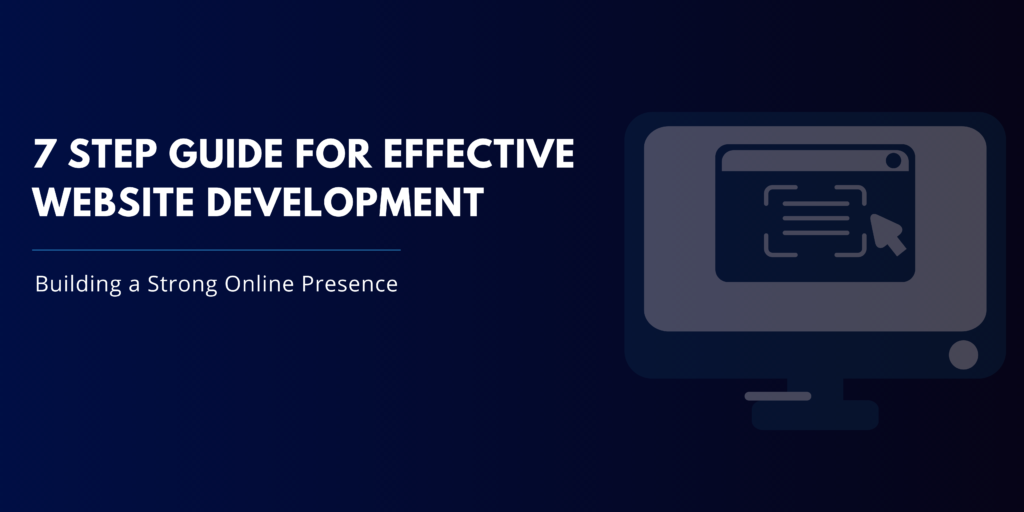7 Step Guide for Effective Website Development: Building a Strong Online Presence

In today’s digital age, a well-designed and functional website is a critical asset for businesses aiming to establish a strong online presence. However, website development can be a complex and daunting process without a clear roadmap.
In this blog, we will walk you through a comprehensive 7-step guide to effective website development, equipping businesses with the knowledge and insights to create a powerful online platform.
Step 1: Defining Goals and Target Audience
Before diving into website development, it is crucial to define your goals and identify your target audience. Clearly articulate what you want to achieve with your website, whether it’s generating leads, driving sales, or increasing brand awareness.
Conduct thorough research to understand your target audience’s preferences, needs, and demographics. This information will inform your design choices, content strategy, and overall website structure, ensuring that your website resonates with your intended audience and achieves its objectives.
Step 2: Planning and Wireframing
The next step is to plan the structure and layout of your website. Create a sitemap that outlines the various pages and sections you want to include. This will provide a visual representation of the website’s structure.
Consider creating wireframes, which are basic sketches or mock-ups of each page’s layout and content placement. Wireframes help you visualize the user interface and ensure a logical flow of information. Taking the time to plan and wireframe your website allows for efficient development and minimizes the chances of major design changes later on.
Step 3: Engaging Design and User Experience
Website design plays a crucial role in attracting and engaging visitors. Consider the visual aesthetics, color scheme, typography, and overall branding consistency. Ensure that the design aligns with your target audience’s preferences and creates a positive first impression.
Prioritize user experience (UX) by implementing intuitive navigation, clear calls to action, and responsive design to ensure seamless functionality across devices. A well-designed and user-friendly website enhances engagement, encourages visitors to stay longer, and improves conversion rates.
Step 4: Compelling Content Creation
Quality content is the backbone of any successful website. Craft compelling and relevant content that aligns with your target audience’s interests and needs. Incorporate SEO keywords naturally throughout your content to improve search engine visibility. Utilize a mix of informative articles, engaging visuals, and multimedia elements to create a diverse and engaging user experience.
Regularly update your website with fresh and valuable content to encourage repeat visits and establish yourself as an industry authority. Remember, high-quality content not only attracts visitors but also encourages them to take desired actions, such as making a purchase or contacting your business.
Step 5: Development and Coding
With the planning and design phases complete, it’s time to bring your website to life through development and coding. Depending on your requirements, you may choose to develop a custom website from scratch or utilize a content management system (CMS) such as WordPress or Joomla.
Focus on writing clean and efficient code to ensure optimal website performance and fast loading times. Pay attention to responsive design, ensuring that your website is accessible and visually appealing across various devices and screen sizes. Thoroughly test your website’s functionality, compatibility, and usability to ensure a seamless browsing experience.
Step 6: Integration of Essential Features
To enhance the functionality and user experience of your website, integrate essential features such as contact forms, social media integration, e-commerce capabilities, and analytics tools. Contact forms allow visitors to reach out to your business, while social media integration enables seamless sharing of content and expands your online reach. For businesses with e-commerce goals, integrate a secure and user-friendly online shopping system that facilitates easy transactions.
Additionally, implement analytics tools such as Google Analytics to gain insights into website traffic, user behavior, and conversion rates. By integrating these essential features, you can maximize the effectiveness of your website and provide a seamless experience for your audience.
Step 7: Testing, Launch, and Ongoing Maintenance
Before launching your website, thorough testing is essential to ensure that everything functions as intended. Conduct comprehensive testing across different browsers, devices, and operating systems to identify and address any compatibility issues. Test all forms, links, and interactive elements to guarantee a smooth user experience. Once testing is complete, it’s time to launch your website and make it live.
However, website development is an ongoing process, and regular maintenance is crucial to keep your site secure, up-to-date, and optimized for performance. Regularly monitor website analytics, update content, and implement security patches to maintain a strong online presence and adapt to changing industry trends.
Conclusion
Building an effective website requires careful planning, attention to detail, and a focus on user experience. By following this 7-step guide to website development, businesses can create a powerful online platform that engages visitors, drives conversions, and establishes a strong online presence. From defining goals and understanding the target audience to planning, designing, developing, and integrating essential features, each step contributes to a comprehensive and successful website.
Remember, effective website development is an ongoing process that requires regular updates and maintenance to keep pace with evolving user expectations and technological advancements.
